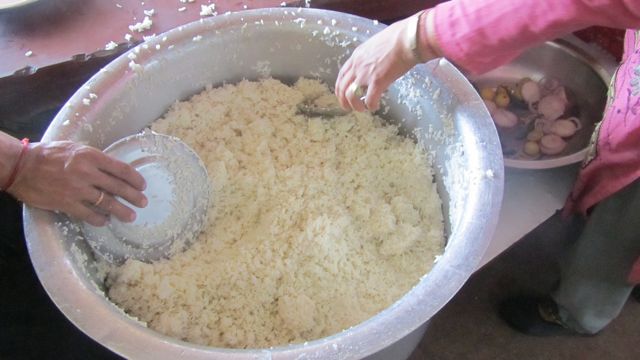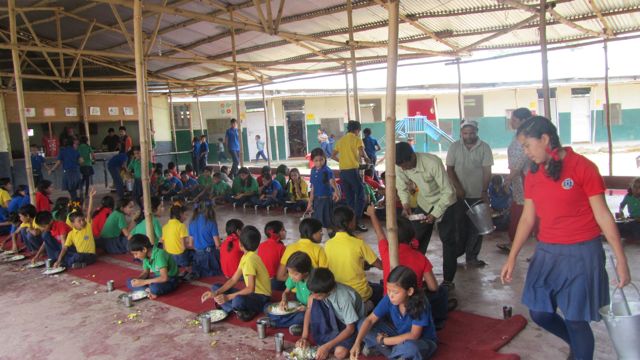FAQ- The Nepali Diet (All About Food)
Tuesday, July 16, 2013

My lunch in Nepal
Everyone is always asking me what the kids and I eat. I've noticed this question a lot since I've been back. "What's the diet like? What are the local staples? What do the children eat at meal time? Where does our food come from and who makes it?"
Nepal is one of the most food deficit countries in the world, yet just about everyone subsistence farms. Food is never wasted and always shared. At Kopila Valley, we try to grow as much of our own food as possible. Every square inch of our yard and our neighbors' is covered with vegetables and fruit trees. We plant and eat whatever is in season. For example, we'll grow broccoli, that's all we eat for 2 weeks and then when it's finished, we move onto the next vegetable, like green beans, peas, pumpkin, or mustard greens.
What we don't grow, we source from local farmers. Early in the morning women come carrying vegetables in big baskets called "dhokas" on their backs before they head to market. We buy from them in bulk and they give us good rates, trying to unload as many fruits and vegetables as possible in one spot. We've become close to many of these women. Gagan Malla, one of my dear friends and one of the favorite uncles around Kopila, arranges and orders our ration supply (sugar, flour, tea, beans, and rice).
The staples are definitely white rice, lentils, and potatoes potatoes potatoes. If you ask my Fellows and volunteers about food variety, they would probably roll their eyes and crack some jokes. We eat a lot of the same exact things around here. My dad is always joking with everyone and saying "I wonder what's for dinner tonight." It's almost always the same thing.
Saturdays at our house are meat night... once a week. Some of my children are vegetarian and some are not. I leave this as a personal choice for them. We follow Hindu and Buddhist practices and do not eat cow, buffalo, or pig meat. Every Saturday night the Aunties make a goat stew or (my favorite) chicken soup. We try to eat animals that we raise. We almost always slaughter and butcher them ourselves. Our entire family eats about 14 chickens for dinner. It's really sad when one of the uncles comes on the motorcycle carrying them all alive. An hour later they are in our soup. It's definitely different than buying meat at the grocery store. On Friday nights we make spaghetti. The kids really didn't like spaghetti at first. Actually, they didn't like anything they couldn't recognize or hadn't seen before and whenever I'd make them try something new, they'd look at me and be like "mom, can't we just have rice?" But now they look forward to pasta night. The American in me also insisted that I get them all to love peanut butter. SUCCESS!
Meat and fruit are probably the most expensive thing in our budget. Fruits are available seasonally. During the summer there is an abundance of mangos, litchi, bananas, papaya and guava on a rotating basis. During the winter, the most delicious clementines come from Dailek and there is a month or so of the best Himalayan apples ever from up in the Jumla mountains. Sometimes a specific thing, like grapes, or kafal berries, water melon or sweet potatoes pop up for a week but then they're gone almost as fast as they appeared. My fruit vendor always saves the good stuff for us. We are lucky. The kids and Nena love fresh coconut that comes from India. That's a favorite treat around here.
When I'm here in the U.S. it makes me sad to see packaged and synthetic food everywhere. I worry about our children here, our food culture and the American diet. I see more and more packaged junk food coming to Nepal. The children celebrate when they get greens or a slice of cucumber or carrot or lemon with their lunch. A hard boiled egg for breakfast is their favorite thing in the world. It's amazing how different the paradigm is with food in Nepal and other parts of the world. It's always a rough adjustment for me going back and forth. Most of the children at our school don't get fruit or a wide variety of vegetables. Homemade raw yogurt is a rare and special treat. They eat these things like candy. When Anjali was here in the U.S. she didn't really enjoy sweets or ice-cream or pizza or anything fun that I wanted her to. I'd have to beg her to eat them. Every day she'd cook up a 6 egg omelette and make herself hash brown potatoes or cooked greens. Everyone likes the food they are accustomed to.
My least favorite thing about the diet in Nepal is the mustard oil. That's all we ever cook with. It tastes a little bitter and you have to let it burn off for a while before you cook your veggies. I'm always telling the cooks to use less. My favorite thing about the diet is the "dal" lentil soup every day. Fresh "Roti" tortillas for dinner are also delicious, especially cooked over the fire or fresh off the stove. I stop in the kitchen every day on my way home from school and grab one and the kids are always lingering outside the kitchen waiting for dinner. I bring salad seeds back and we eat that a lot too as a treat. Most Nepali people don't eat any raw vegetables.
Our food is prepared and cooked by a wonderful team of men and women. We call them the "aunties and uncles." They are always smiling. They cook with gas bottles that get delivered and refilled every few days. The gas bottles hook up to a stove via a long pipe. We use huge pots for the rice and pressure cookers for the beans. Our food and gas bottles make up for 50% of our entire operating budget. Having healthy and nourished children is a very important objective for us and I try to keep them as connected to food and where it comes from as possible. Hunger is something we see every single day, so we try to waste as little as possible. Everyone helps with serving at lunch, the teachers, the kids/ house leaders, and the volunteers. The children sitting together eating breakfast, lunch and dinner are always my favorite moments of the day. At home, I make the kids count off to 40 to make sure everyone is sitting around the table together at meal time. It's quite the scene.
Here are some photos I put together of food, food and more food. I'd be happy to answer any questions about meals, or food or anything! Ask away.

Shova auntie pealing garlic

Lachimey Auntie preparing and cleaning the lentils

June is corn month! There is so much of it.

Our school garden

Nepal's rice paddies are beautiful and seen everywhere throughout our valley

Rice pot

School lunch in the Kopila cafeteria

The teachers eat with the kids

Everyone knows how much I love this woman! Our dear Bauju, head of the kitchen.

Cutie pies eating lunch

The kitchen counter